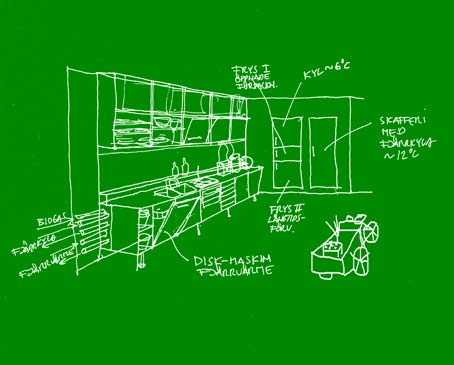The Sustainable Kitchen
This is how a kitchen could look like in the future when we have established a lifestyle in harmony with the eco-system.

We have started to build wisely, using local materials with little environmental impact with highly developed “spare part thinking”. The kitchen is built of solid wood, nice to work with, resist tough use, ageing gracefully, can easily be repaired or/and repainted and is renewable. Glass, steel/stainless steel that is non renewable is kept in it’s pure form so that it can be separated and recycled.



We have transformed the energy sector away from non-renewable energy sources to producing and using energy wisely. The fridge is small and is used only for the products that need to be cold (+6 degrees Celsius), a freezer with two doors, the smaller for opened packaging, ice etc. that is used daily and the bigger for more “long-term” storage. The cooling for the larder is provided by means of district cooling making it work all year around, the temperature is +12 degrees Celsius. The larder is used for all products that do not need/is better kept not so cold, such as vegetables, fruits, oil, vinegar, wine etc. Hot water to the dishwasher is provided by means of district heating. It is only using 15 l water/washing. The gas hob is fuled by biogas produced from organic waste. We have transformed food production away from the large scale industrial farming to local production on the terms of the eco-system, without chemical fertilizers and pesticides.

We cook food from locally produced products with as short food-chains as possible. We have transformed the transportation sector away from the internal combustion engine to electrified goods transport and public transport in combination with soft mobility (walking and bicycle). The transportation bicycle has a fantastic loading capacity!

We have transformed the packaging sector away from open ended resource wasting systems to reuse/recycle systems with closed resource cycles as far as possible. The plastic crates around which the larder is built is an example of such a wise packaging strategy. The crates can be cleaned and reused and will last for at least 20 years. All “wet” products is packaged in glass that is within a reuse system, products such as butter, meat, fish, cheese, etc. in plastic boxes that is reused. Dry products are packaged in paper that is recycled.

We have stopped using disposable, throwaway objects and we use utensils and equipment that has been responsibly produced, that last long and age with dignity.



.........and no, we do not need to live in caves…… /Olof Kolte



year of conception: 2007
copyright: Olof Kolte
Design